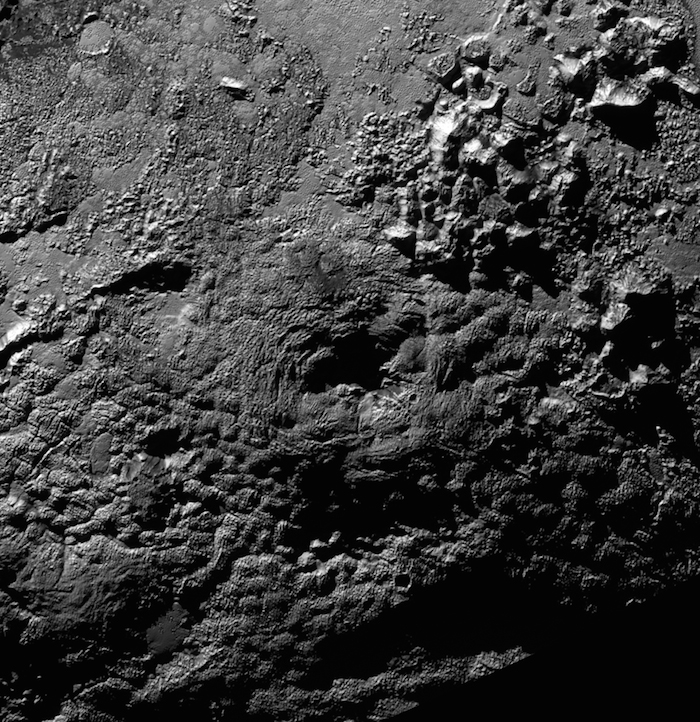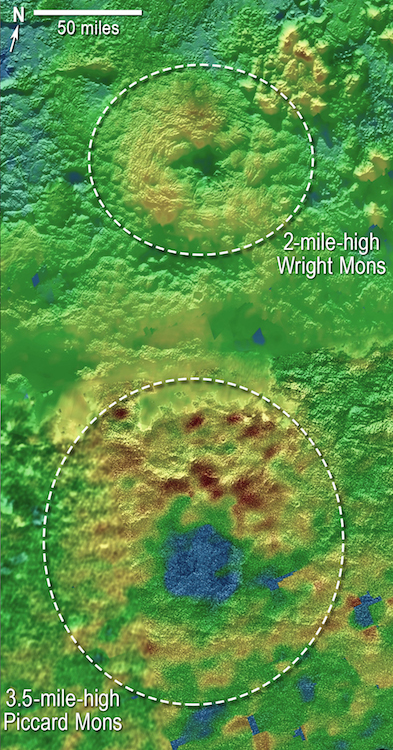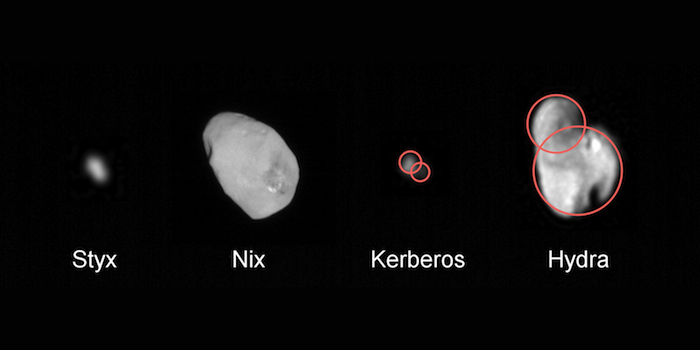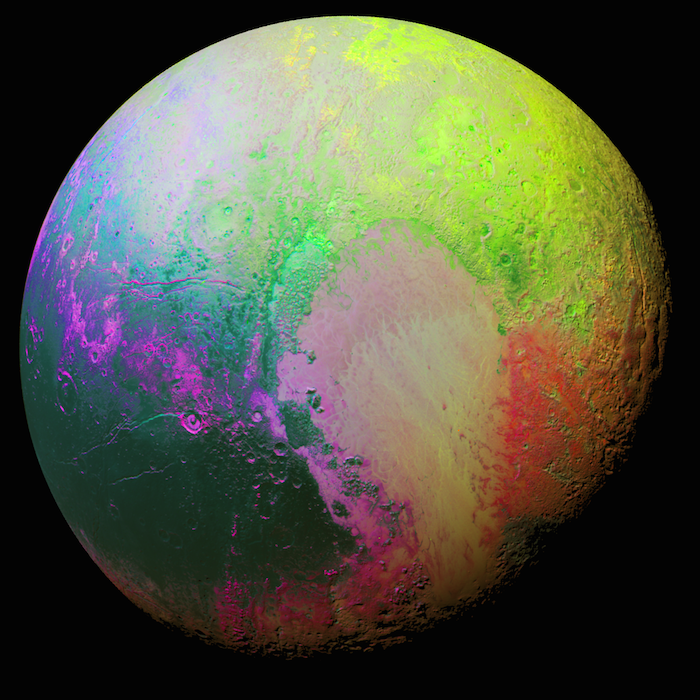.
22.10.2015
Letzter Mysteriöser Pluto-Mond Kerberos - von New Horizons enthüllt

Kerberos Revealed. This image of Kerberos was created by combining four individual Long Range Reconnaissance Imager (LORRI) pictures taken on July 14, approximately seven hours before New Horizons’ closest approach to Pluto, at a range of 245,600 miles (396,100 km) from Kerberos. The image was deconvolved to recover the highest possible spatial resolution and oversampled by a factor of eight to reduce pixilation effects. Kerberos appears to have a double-lobed shape, approximately 7.4 miles (12 kilometers) across in its long dimension and 2.8 miles (4.5 kilometers) in its shortest dimension.
Credits: NASA/JHUAPL/SwRI
-
Images of Pluto’s tiny moon Kerberos taken by NASA’s New Horizons spacecraft –and just sent back to Earth this week – complete the family portrait of Pluto’s moons.
Kerberos appears to be smaller than scientists expected and has a highly-reflective surface, counter to predictions prior to the Pluto flyby in July. “Once again, the Pluto system has surprised us,” said New Horizons Project Scientist Hal Weaver, of the Johns Hopkins University Applied Physics Laboratory in Laurel, Maryland.
The new data, downlinked from the New Horizons spacecraft on Oct. 20, show that Kerberos appears to have a double-lobed shape, with the larger lobe approximately 5 miles (8 kilometers) across and the smaller lobe approximately 3 miles (5 kilometers) across. Science team members speculate from its unusual shape that Kerberos could have been formed by the merger of two smaller objects. The reflectivity of Kerberos’ surface is similar to that of Pluto’s other small moons (approximately 50 percent) and strongly suggests Kerberos, like the others, is coated with relatively clean water ice.
Before the New Horizons encounter with Pluto, researchers had used Hubble Space Telescope images to “weigh” Kerberos by measuring its gravitational influence on its neighboring moons. That influence was surprisingly strong, considering how faint Kerberos was. They theorized that Kerberos was relatively large and massive, appearing faint only because its surface was covered in dark material. But the small, bright-surfaced Kerberos--now revealed in these new images--shows that the idea was incorrect, for reasons that are not yet understood.
“Our predictions were nearly spot-on for the other small moons, but not for Kerberos,” said New Horizons co-investigator Mark Showalter, of the SETI Institute in Mountain View, California. The new results are expected to lead to a better understanding of Pluto’s fascinating satellite system.
.

Family Portrait of Pluto’s Moons: This composite image shows a sliver of Pluto’s large moon, Charon, and all four of Pluto’s small moons, as resolved by the Long Range Reconnaissance Imager (LORRI) on the New Horizons spacecraft. All the moons are displayed with a common intensity stretch and spatial scale (see scale bar). Charon is by far the largest of Pluto’s moons, with a diameter of 751 miles (1,212 kilometers). Nix and Hydra have comparable sizes, approximately 25 miles (40 kilometers) across in their longest dimension above. Kerberos and Styx are much smaller and have comparable sizes, roughly 6-7 miles (10-12 kilometers) across in their longest dimension. All four small moons have highly elongated shapes, a characteristic thought to be typical of small bodies in the Kuiper Belt.
Quelle: NASA
-

Global stereo mapping of Pluto’s surface is now possible, as images taken from multiple directions are downlinked from NASA’s New Horizons spacecraft. Stereo images will eventually provide an accurate topographic map of most of the hemisphere of Pluto seen by New Horizons during the July 14 flyby, which will be key to understanding Pluto’s geological history.
This example, which requires red/blue stereo glasses for viewing, shows a region 180 miles (300 kilometers) across, centered near longitude 130 E, latitude 20 N (the red square in the global context image). North is to the upper left. The image shows an ancient, heavily cratered region of Pluto, dotted with low hills and cut by deep fractures indicating extension of Pluto’s crust.
Analysis of these stereo images shows that the steep fracture in the upper left of the image is about 1 mile (1.6 kilometers) deep, and the craters in the lower right part of the image are up to 1.3 miles (2.1 km) deep. Smallest visible details are about 0.4 miles (0.6 kilometers) across.
Quelle: NASA
-
Update: 30.10.2015
.
The Youngest Crater on Charon?

This composite image is based on observations from the New Horizons Ralph/LEISA instrument made at 10:25 UT (6:25 a.m. EDT) on July 14, 2015, when New Horizons was 50,000 miles (81,000 kilometers) from Charon. The spatial resolution is 3 miles (5 kilometers) per pixel. The LEISA data were downlinked Oct. 1-4, 2015, and processed into a map of Charon’s 2.2 micron ammonia-ice absorption band. Long Range Reconnaissance Imager (LORRI) panchromatic images used as the background in this composite were taken about 8:33 UT (4:33 a.m. EDT) July 14 at a resolution of 0.6 miles (0.9 kilometers) per pixel and downlinked Oct. 5-6. The ammonia absorption map from LEISA is shown in green on the LORRI image. The region covered by the yellow box is 174 miles across (280 kilometers).
.
New Horizons scientists have discovered a striking contrast between one of the fresh craters on Pluto’s largest moon Charon and a neighboring crater dotting the moon’s Pluto-facing hemisphere.
The crater, informally named Organa, caught scientists’ attention as they were studying New Horizons’ highest-resolution infrared compositional scan of Charon. Organa and portions of the surrounding material ejected from it show infrared absorption at wavelengths of about 2.2 microns, indicating that the crater is rich in frozen ammonia – and, from what scientists have seen so far, unique on Pluto’s largest moon. The infrared spectrum of nearby Skywalker crater, for example, is similar to the rest of Charon's craters and surface, with features dominated by ordinary water ice.
Using telescopes, scientists first observed ammonia absorption on Charon in 2000, but the concentrations of ammonia around this crater are unprecedented.
"Why are these two similar-looking and similar-sized craters, so near to each other, so compositionally distinct?" asked Will Grundy, New Horizons Composition team lead from Lowell Observatory in Flagstaff, Arizona. "We have various ideas when it comes to the ammonia in Organa. The crater could be younger, or perhaps the impact that created it hit a pocket of ammonia-rich subsurface ice. Alternatively, maybe Organa’s impactor delivered its own ammonia."
Both craters are about the same size – roughly 5 kilometers [3 miles] in diameter – with similar appearances, including bright wisps or rays of ejected material, or ejecta. One apparent difference is that Organa has a central region of darker ejecta, though from the map created with data from New Horizons’ Ralph/LEISA instrument, it appears that the ammonia-rich material extends beyond this dark area.
“This is a fantastic discovery,” said Bill McKinnon, deputy lead for the New Horizons Geology, Geophysics and Imaging team from Washington University in St. Louis. “Concentrated ammonia is a powerful antifreeze on icy worlds, and if the ammonia really is from Charon’s interior, it could help explain the formation of Charon’s surface by cryovolcanism, via the eruption of cold, ammonia-water magmas.”
Quelle: NASA
-
Plutos Sichel schimmert in neue NASA-Foto

A new NASA picture of Pluto shows the dwarf planet as a thin crescent enveloped in a film of haze.
The photo, released Thursday, was taken by NASA's New Horizons spacecraft just 15 minutes after the spacecraft made its closest pass by Pluto in July 2015, the space agency said. The photo is a more complete version of a partial image of Pluto's crescent released earlier this year.
"The wide-angle perspective of this view shows the deep haze layers of Pluto's atmosphere extending all the way around Pluto, revealing the silhouetted profiles of rugged plateaus on the night (left) side. The shadow of Pluto cast on its atmospheric hazes can also be seen at the uppermost part of the disk," NASA said in a statement.
For scientists, there's a lot to ogle over in the high-resolution image.
The peaks of some of the dwarf planet's giant ice mountains can also be seen in the image on the sunlit side, NASA said, and the photo also shows stars — which look like bright, thin lines — in the black sky behind the small world captured as New Horizons sped past.
.

New Horizons is now making its way deeper into the Kuiper Belt — the area of space where Pluto sits. The spacecraft has successfully performed three of four maneuvers to get it on a course to meet up with another target in that part of space by 2019.
If NASA chooses to extend New Horizons' mission, the probe should meet up with the small body called 2014 MU69 by 2019, beaming back images of the world as it flies by.
Quelle: Mashable
-
Update: 9.11.2015
.
At Pluto, New Horizons Finds Geology of All Ages, Possible Ice Volcanoes, Insight into Planetary Origins
From possible ice volcanoes to geologically diverse surfaces to oddly behaving moons that could have formed through mergers of smaller moons, Pluto system discoveries continue to surprise scientists on NASA’s New Horizons mission team.
“The New Horizons mission has taken what we thought we knew about Pluto and turned it upside down,” said Jim Green, director of planetary science at NASA Headquarters in Washington. “It’s why we explore – to satisfy our innate curiosity and answer deeper questions about how we got here and what lies beyond the next horizon.”
.

Ice Volcanoes on Pluto?
Release Date: November 9, 2015
Keywords: LORRI, Pluto
The informally named feature Wright Mons, located south of Sputnik Planum on Pluto, is an unusual feature that's about 100 miles (160 kilometers) wide and 13,000 feet (4 kilometers) high. It displays a summit depression (visible in the center of the image) that's approximately 35 miles (56 kilometers) across, with a distinctive hummocky texture on its sides. The rim of the summit depression also shows concentric fracturing. New Horizons scientists believe that this mountain and another, Piccard Mons, could have been formed by the 'cryovolcanic' eruption of ices from beneath Pluto's surface.
.
The New Horizons team is discussing numerous findings at the 47th Annual Meeting of the Division for Planetary Sciences (DPS) of the American Astronomical Society (AAS) this week in National Harbor, Maryland. Just four months after the spacecraft encountered Pluto, science team members are presenting more than 50 reports on exciting discoveries.
“It’s hard to imagine how rapidly our view of Pluto and its moons are evolving as new data stream in each week. As the discoveries pour in from those data, Pluto is becoming a star of the solar system,” said mission Principal Investigator Alan Stern of the Southwest Research Institute, Boulder, Colorado. “Moreover, I’d wager that for most planetary scientists, any one or two of our latest major findings on one world would be considered astounding. To have them all is simply incredible.”
In one such discovery, New Horizons geologists have combined images of Pluto’s surface to make 3-D maps that indicate that two of Pluto’s most distinctive mountains could be cryovolcanoes—ice volcanoes that may have been active in the recent geological past.
The two cryovolcano candidates are large features measuring tens of miles (tens of kilometers) across and several miles or kilometers high. “These are big mountains with a large hole in their summit, and on Earth that generally means one thing—a volcano,” said Oliver White, New Horizons postdoctoral researcher with NASA’s Ames Research Center, Moffett Field, California. While their appearance is similar to volcanoes on Earth that spew molten rock, ice volcanoes on Pluto are expected to emit a somewhat melted slurry of substances such as water ice, nitrogen, ammonia, or methane on Pluto.
White stresses that the team’s interpretation of these features as volcanoes is tentative. However, “If they are volcanic, then the summit depression would likely have formed via collapse as material is erupted from underneath. The strange hummocky texture of the mountain flanks may represent volcanic flows of some sort that have travelled down from the summit region and onto the plains beyond, but why they are hummocky, and what they are made of, we don't yet know.”
If Pluto is proven to have volcanoes, it will provide an important new clue to its geologic and atmospheric evolution. “After all, nothing like this has been seen in the deep outer solar system,” said Jeffrey Moore, New Horizons Geology, Geophysics and Imaging team leader, also from NASA Ames.
.

Ice Volcanoes and Topography
Release Date: November 9, 2015
Keywords: LORRI, Pluto, Ralph
Scientists using New Horizons images of Pluto's surface to make 3-D topographic maps have discovered that two of Pluto’s mountains, informally named Wright Mons and Piccard Mons, could possibly be ice volcanoes. The color is shown to depict changes in elevation, with blue indicating lower terrain and brown showing higher elevation; green terrains are at intermediate heights.
.
Pluto’s Long History of Geologic Activity
Another of the more surprising findings from New Horizons is the wide range of surface ages found on Pluto, from ancient to intermediate to relatively young in geological terms. Crater counts used to determine surface unit ages indicate that Pluto has ancient surface areas dating to just after the formation of the planets, about 4 billion years ago. In addition, there’s a vast area that was geologically born “yesterday,” meaning it may have formed within the past 10 million years. This area – informally named Sputnik Planum – appears on the left side of Pluto’s “heart” and is completely impact-free in all images returned to date.
Scientists wondered if Sputnik Planum’s smooth, icy plains were an oddity; did a recent geological episode form the plains long after all other geologic activity ceased?Apparently not. New data from crater counts reveal the presence of intermediate or “middle-aged” terrains on Pluto as well. This suggests that Sputnik Planum is not an anomaly—that Pluto has been geologically active throughout much of its more than 4-billion-year history. “We’ve mapped more than a thousand craters, which vary greatly in size and appearance,” said postdoctoral researcher Kelsi Singer, of the Southwest Research Institute (SwRI) in Boulder, Colorado. “Among other things, I expect cratering studies like these to give us important new insights into how this part of the solar system formed.”
.

Craters of All Ages and Sizes
Release Date: November 9, 2015
Keywords: LORRI, Pluto
Locations of more than 1,000 craters mapped on Pluto by NASA's New Horizons mission indicate a wide range of surface ages, which likely means that Pluto has been geologically active throughout its history.
.
Building Blocks of the Solar System
Crater counts are giving the New Horizons team insight into the structure of the Kuiper Belt itself. The dearth of smaller craters across Pluto and its large moon Charon indicate that the Kuiper Belt likely had fewer smaller objects than some models had predicted. This leads New Horizons scientists to doubt a longstanding model that all Kuiper Belt objects formed by accumulating much smaller objects of less than a mile wide. The absence of small craters on Pluto and Charon support other models theorizing that Kuiper Belt objects tens of miles across may have formed directly, at their current—or close to current—size.
In fact, the evidence that many Kuiper Belt objects could have been “born large” has scientists excited that New Horizons’ next potential target – the 30-mile-wide (40-50 kilometer wide) KBO named 2014 MU69 – which may offer the first detailed look at just such a pristine, ancient building block of the solar system.
.
Spinning, Merged Moons
The New Horizons mission is also shedding new light on Pluto’s fascinating system of moons and their unusual properties. For example, nearly every other moon in the solar system, including Earth’s moon, is in synchronous rotation, but not so of Pluto’s small moons. These small satellites are spinning much faster, with Hydra – the most distant moon - rotating an unprecedented 89 times during a single lap around Pluto. Scientists believe these spin rates could be chaotic (i.e., variable) because Charon exerts a strong torque that prevents each small moon from settling down into synchronous rotation, which means keeping one face toward the planet.
Another oddity of Pluto’s moons: scientists expected the satellites to wobble, but not to this degree. “Pluto’s moons are behaving like spinning tops,” said co-investigator Mark Showalter of the SETI Institute in Mountain View, California.
Images of Pluto’s four smallest satellites also indicate that several of them could have been born from mergers of two or more former moons, suggesting the presence of more moons at some point. “We suspect from this that Pluto had more moons in the past, in the aftermath of the big impact that also created Charon,” said Showalter.
.

New Horizons data indicates that at least two (and possibly all four) of Pluto’s small moons may be the result of mergers between still smaller moons. If this discovery is borne out with further analysis, it could provide important new clues to the formation of the Pluto system.
.
Pluto’s Frigid, Extended Atmosphere
The New Horizons team is presenting new data at DPS that reveal Pluto’s upper atmosphere is significantly colder and therefore more compact than Earth-based models had indicated. As a result, scientists have discovered that Pluto’s atmospheric escape rate is thousands of times lower than had been thought. It now appears that Pluto’s atmosphere escapes by the same mechanism as do gases from the atmospheres of Earth and Mars – rather than the previously believed escape process that more resembled escape from cometary atmospheres.
New Horizons is part of NASA's New Frontiers Program, managed by the agency's Marshall Space Flight Center in Huntsville, Alabama. The Johns Hopkins University Applied Physics Laboratory in Laurel, Maryland, designed, built, and operates the New Horizons spacecraft and manages the mission for NASA's Science Mission Directorate. The Southwest Research Institute leads the science mission, payload operations, and encounter science planning.
Quelle: NASA
.
Update: 13.11.2015
.
Psychedelic Pluto

New Horizons scientists made this false color image of Pluto using a technique called principal component analysis to highlight the many subtle color differences between Pluto's distinct regions. The image data were collected by the spacecraft’s Ralph/MVIC color camera on July 14 at 11:11 AM UTC, from a range of 22,000 miles (35,000 kilometers). This image was presented by Will Grundy of the New Horizons’ surface composition team on Nov. 9 at the Division for Planetary Sciences (DPS) meeting of the American Astronomical Society (AAS) in National Harbor, Maryland.
Quelle: NASA
-
Update: 21.11.2015
.
This Is What a Day on Pluto and Charon Looks Like

On approach in July 2015, the cameras on NASA’s New Horizons spacecraft captured Pluto rotating over the course of a full “Pluto day.” The best available images of each side of Pluto taken during approach have been combined to create this view of a full rotation. NASA/JHUAPL/SWRI
Although the NASA New Horizons mission’s close encounter with the Pluto system lasted a matter of hours, the probe was still able to image a full “day” on Pluto and largest moon Charon.
Both Pluto and Charon are a tidally locked system — i.e. the same hemisphere of Charon always faces the same hemisphere of Pluto — so their days span the same amount of time. One rotation of the Pluto-Charon system is 6.4 Earth-days long, so as New Horizons began its approach, it was already taking photos.
-
The flyby would only reveal one side of Pluto and Charon, but as shown in these sequences, the probe started taking observations long before point of closest approach, allowing us a glimpse — albeit a blurry glimpse — of the “binary planet’s” far side.
New Horizons used its Long Range Reconnaissance Imager (LORRI) and Ralph/Multispectral Visible Imaging Camera to capture observations from 5 million miles (8 million kilometers) distant on July 7 to 400,000 miles (645,000 kilometers) on July 13. Closest approach occurred on July 14, when the mission came within 7,800 miles (12,500 kilometers) of the dwarf planet’s surface. But in the lead-up to close approach, New Horizons was able to see an entire day in the Pluto-Charon system.
-
Most striking are the peculiar cluster of (what appear to be) impact craters on the “far side” of Pluto (the images shown at the 10 o’clock to 2 o’clock positions). These features were quickly sighted as New Horizons began its dive into the Pluto system, but mission scientists knew that this would be the best view they’d get of the small world’s far side.
The rest of the mission’s imagery would be filled with the vast dynamic plains and frozen mountain ranges we are becoming intimately familiar with in the months since flyby. The observation in the 6 o’clock position is what is known as the mission’s “encounter hemisphere”, showcasing Pluto’s now-famous “heart” — informally known as Tombaugh Regio.
.

On approach to the Pluto system in July 2015, the cameras on NASA’s New Horizons spacecraft captured images of the largest of Pluto’s five moons, Charon, rotating over the course of a full day. The best currently available images of each side of Charon taken during approach have been combined to create this view of a full rotation of the moon.
NASA/JHUAPL/SWRI
As for Charon, its surface contrasts greatly with the variations visible on Pluto’s surface. In this sequence of images, Charon’s “encounter hemisphere” is showcased at the 12 o’clock position. The most distant image of the moon’s far side is at the 9 o’clock position.
Quelle: D-News
4836 Views
